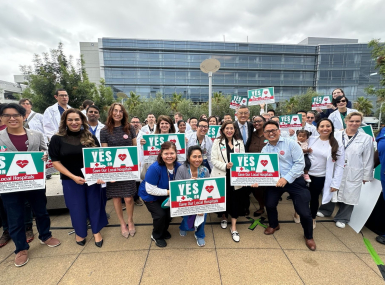NACo members get briefing on coronavirus from CDC
Author
Upcoming Events
Related News

Key Takeaways
With more cases of the coronavirus appearing across the United States, federal agencies are working with local officials to take preventative measures.
Representatives from the Centers for Disease Control and Prevention (CDC) and the Department of Health and Human Services discussed the coronavirus outbreak Sunday during NACo’s Large Urban County Caucus Meeting during NACo’s 2020 Legislative Conference in Washington D.C.
CDC’s Chief Medical Officer Mitch Wolfe said the CDC is working closely with health departments to assess local readiness for the virus. He said the center is encouraging counties and states to review their pandemic preparedness plans.
The 2019 coronavirus, now known as COVID-19, was first identified in Wuhan, China and is part of a large family of viruses that cause respiratory illness.
The virus causes symptoms similar to a mild or moderate upper respiratory infection like a common cold, but can also cause more severe diseases like pneumonia and bronchitis, specifically in infants, young children and older adults.
“I think the most important thing I can say that you can take back is everyday preventative measures for respiratory illness,” Wolfe said.
Learn More
This includes washing hands, using alcohol-based sanitizers, avoiding touching the eyes, nose or mouth with unwashed hands, avoiding close contact with people who are sick, staying home when sick and disinfecting objects that were touched. The CDC does not recommend using face masks, Wolfe said, because the virus can also be spread through touching the face after touching a contaminated surface.
“Again, routine respiratory precautions especially in public are going to be very important for preventative disease spreading,” Wolfe said.
The virus spreads from an infected person to others by respiratory droplets, coughing or sneezing. Individuals can get infected from being in close contact with another sick individual or touching an object or surface that has the virus on it.
Currently, there are ongoing investigations into how the virus spreads, Wolfe said. The virus is presumed to spread primarily from close person-to-person contact or when someone coughs or sneezes. It is unknown how long the virus lasts on surfaces.
The case fatality rate is between 0.5 percent and 1 percent, with a higher rate in China, according to Wolfe. He noted that this rate depends on multiple factors such as the healthcare setting and total number of cases found in an area.
The estimated incubation period is between two to 14 days. Wolfe said the CDC is working with a number of modeling agencies to try to examine the length of its incubation period.
In King County, Wash., officials opened an emergency operations center Saturday after announcing the nation’s first coronavirus death, a man in his 50s. Officials confirmed the second coronavirus death of a man in his 70s, also from King County, on Sunday.
On Saturday morning, King County Executive Dow Constantine returned to King County from Washington, D.C., where he was attending the NACo Legislative Conference.
“We are rapidly shifting our operations here to be focused primarily on dealing with this crisis,” Constantine said at a news conference about the coronavirus death.
The county is exploring options for any homeless to have places to stay to recover from coronavirus away from shelters, he said. Public transportation is also being monitored extra carefully for cleanliness.
U.S. Department of Health and Human Services Deputy Secretary Eric Hargan told county officials the department is working with Vice President Mike Pence, who is leading the response to the coronavirus, as well as Health and Human Services Secretary Alex Azar.
Hargan said in response to the coronavirus, the White House has sent a request to Congress for supplemental funding, which includes five major areas — expanding surveillance work, therapeutics, developing vaccines, purchasing protective equipment and funding for public health preparedness and response for state and local governments.
“As we continue our response, your partnership in aggressive containment of potential mitigation of community spread will be vital,” he said.
Hargan said the administration takes preparedness seriously, adding that the CDC’s budget has increased by $668 million since fiscal year 2017.
“Our mission is to try to stop disease spread and slow disease spread as much as we can,” Wolfe said. “That’s our goal and mission to try to prevent and slow the spread to the United States.”
Wolfe encouraged county officials to visit www.cdc.gov for the latest information surrounding the coronavirus.

Attachments
Related News

States submit Rural Health Transformation Program funding applications
On December 29, the Centers for Medicare & Medicaid Services (CMS) announced $50 billion in awards over 5 years to all 50 states under the Rural Health Transformation Program.

CMS issues new guidance on Medicaid Community Engagement Requirements
On December 8, the Centers for Medicare & Medicaid Services (CMS) released a Medicaid and CHIP Services Informational Bulletin (CIB) directing states on how to implement the Medicaid community engagement requirements enacted under Section 71119 of the One Big Beautiful Bill Act legislation (Public Law 119-21), or H.R. 1.

California county sales tax measure backfills federal healthcare cuts
Santa Clara County, Calif. will raise an estimated $330 million each year from a sales tax to backfill lose Medicaid funding.
